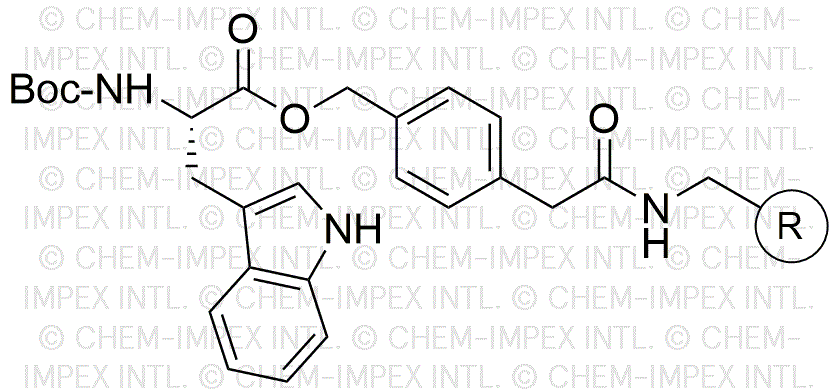Na-Boc-L-tryptophan 4-oxymethylphenylacetamidomethyl is widely utilized in research focused on:
- Peptide Synthesis: This compound serves as a valuable building block in the synthesis of peptides, particularly in the creation of biologically active compounds, enhancing the efficiency of drug development.
- Drug Discovery: It plays a crucial role in medicinal chemistry for developing new pharmaceuticals, especially those targeting neurological disorders, due to its structural similarity to neurotransmitters.
- Bioconjugation: The compound is used in bioconjugation processes, allowing researchers to attach biomolecules to drugs or imaging agents, improving the specificity and efficacy of therapies.
- Research in Neuroscience: Its derivatives are often studied for their potential effects on serotonin pathways, making it a key player in research related to mood disorders and depression.
- Analytical Chemistry: It is utilized in analytical methods for detecting and quantifying tryptophan derivatives in biological samples, aiding in metabolic studies and nutritional research.
General Information
Properties
Safety and Regulations
Applications
Na-Boc-L-tryptophan 4-oxymethylphenylacetamidomethyl is widely utilized in research focused on:
- Peptide Synthesis: This compound serves as a valuable building block in the synthesis of peptides, particularly in the creation of biologically active compounds, enhancing the efficiency of drug development.
- Drug Discovery: It plays a crucial role in medicinal chemistry for developing new pharmaceuticals, especially those targeting neurological disorders, due to its structural similarity to neurotransmitters.
- Bioconjugation: The compound is used in bioconjugation processes, allowing researchers to attach biomolecules to drugs or imaging agents, improving the specificity and efficacy of therapies.
- Research in Neuroscience: Its derivatives are often studied for their potential effects on serotonin pathways, making it a key player in research related to mood disorders and depression.
- Analytical Chemistry: It is utilized in analytical methods for detecting and quantifying tryptophan derivatives in biological samples, aiding in metabolic studies and nutritional research.
Documents
Safety Data Sheets (SDS)
The SDS provides comprehensive safety information on handling, storage, and disposal of the product.
Product Specification (PS)
The PS provides a comprehensive breakdown of the product’s properties, including chemical composition, physical state, purity, and storage requirements. It also details acceptable quality ranges and the product's intended applications.
Certificates of Analysis (COA)
Search for Certificates of Analysis (COA) by entering the products Lot Number. Lot and Batch Numbers can be found on a product’s label following the words ‘Lot’ or ‘Batch’.
Numéro de catalogue
Numéro de lot/série
Certificates Of Origin (COO)
This COO confirms the country where the product was manufactured, and also details the materials and components used in it and whether it is derived from natural, synthetic, or other specific sources. This certificate may be required for customs, trade, and regulatory compliance.
Numéro de catalogue
Numéro de lot/série
Safety Data Sheets (SDS)
The SDS provides comprehensive safety information on handling, storage, and disposal of the product.
DownloadProduct Specification (PS)
The PS provides a comprehensive breakdown of the product’s properties, including chemical composition, physical state, purity, and storage requirements. It also details acceptable quality ranges and the product's intended applications.
DownloadCertificates of Analysis (COA)
Search for Certificates of Analysis (COA) by entering the products Lot Number. Lot and Batch Numbers can be found on a product’s label following the words ‘Lot’ or ‘Batch’.
Numéro de catalogue
Numéro de lot/série
Certificates Of Origin (COO)
This COO confirms the country where the product was manufactured, and also details the materials and components used in it and whether it is derived from natural, synthetic, or other specific sources. This certificate may be required for customs, trade, and regulatory compliance.


